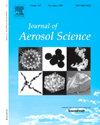利用电场增强石英晶体微天平收集超细颗粒
IF 3.9
3区 环境科学与生态学
Q2 ENGINEERING, CHEMICAL
引用次数: 0
摘要
在本研究中,石英晶体微天平(QCM)技术结合电场测量了超细颗粒(ufp)的粒子质量浓度。利用Sauerbrey方程,可以通过QCM频率的变化估计粒子的质量浓度。电场增强了QCM表面的颗粒收集效率,主要集中在空气动力学直径为30至300 nm的颗粒上。采用多分散NaCl研究了颗粒质量浓度与收集效率和质量灵敏度的关系。使用扫描迁移率粒度仪(SMPS)获得数据。当电压为0 ~ 1 kV,流量为5 L/min时,颗粒浓度变化范围为23.3 ~ 522.8 μg/m³。在23.3 μg/m³、1 kV电压条件下,总收集效率为90.3 ~ 99.5%。QCM表面积累的质量与QCM探测器测得的频移呈线性关系,质量灵敏度为0.177 μg/Hz。基于最小频移和大气ufp的一般浓度,QCM探测器适合每小时测量。QCM的质量灵敏度预测的粒子质量沉积与实测值具有良好的线性拟合(r2 = 0.997),证实了这一点。本文章由计算机程序翻译,如有差异,请以英文原文为准。
Use of electric field to enhance collection of ultrafine particles using quartz crystal microbalance
In the present study, a Quartz Crystal Microbalance (QCM) technique was used in conjunction with an electric field to measure particle mass concentration of ultrafine particles (UFPs). Using Sauerbrey's equation, particle mass concentration can be estimated from the QCM frequency change. An electric field enhanced particle collection efficiency on the QCM surface, focusing on particle sizes ranging from 30 to 300 nm in aerodynamic diameter. Polydisperse NaCl was used to investigate the relationship between particle mass concentration and two key parameters - collection efficiency and mass sensitivity. Data were obtained using the Scanning Mobility Particle Sizer (SMPS). Particle concentrations were varied from 23.3 to 522.8 μg/m³ for applied voltages from 0 to 1 kV at 5 L/min flow. The optimal condition was achieved at 1 kV at a concentration of 23.3 μg/m³, where total collection efficiencies were between 90.3 and 99.5%. The mass accumulated on the QCM surface was linear with the frequency shift measured by a QCM detector, yielding the mass sensitivity of 0.177 μg/Hz. Based on the minimum frequency shift and general concentration of atmospheric UFPs, the QCM detector is appropriate for hourly measurement. This was confirmed by a good agreement between the predicted particle mass deposition by the mass sensitivity of the QCM and the measured one with a linear fit ( = 0.997).
求助全文
通过发布文献求助,成功后即可免费获取论文全文。
去求助
来源期刊

Journal of Aerosol Science
环境科学-工程:化工
CiteScore
8.80
自引率
8.90%
发文量
127
审稿时长
35 days
期刊介绍:
Founded in 1970, the Journal of Aerosol Science considers itself the prime vehicle for the publication of original work as well as reviews related to fundamental and applied aerosol research, as well as aerosol instrumentation. Its content is directed at scientists working in engineering disciplines, as well as physics, chemistry, and environmental sciences.
The editors welcome submissions of papers describing recent experimental, numerical, and theoretical research related to the following topics:
1. Fundamental Aerosol Science.
2. Applied Aerosol Science.
3. Instrumentation & Measurement Methods.
 求助内容:
求助内容: 应助结果提醒方式:
应助结果提醒方式:


